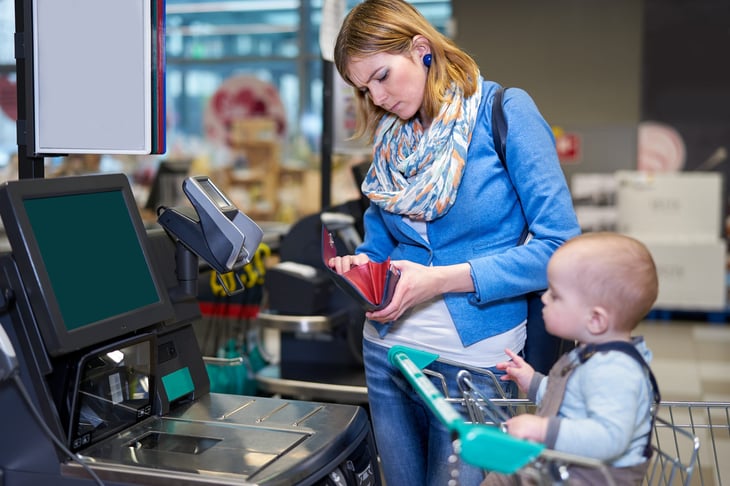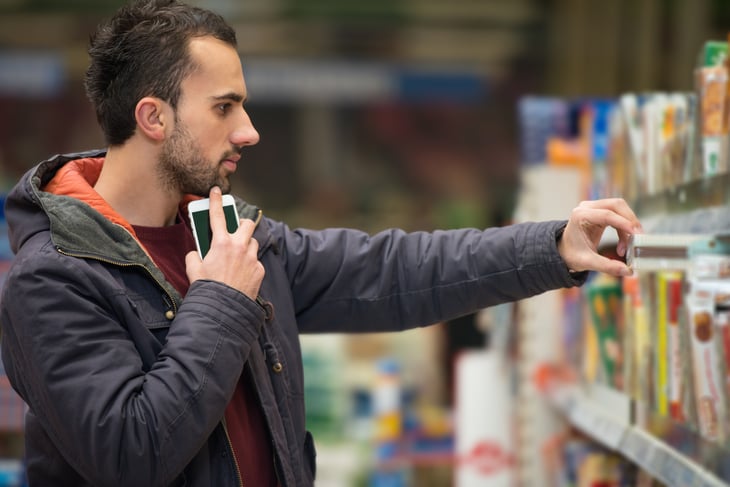
Many people don’t think of groceries as a “bill,” but buying them can be one of a household’s biggest recurring expenses.
It’s also a highly variable expense, subject to inflation, supply and even how much we’ve had to eat before we go shopping.
With such a major and frequent expense, any savings you can find — and missteps you can avoid — will add up fast. So, let’s take a look at some of the costly mistakes you’ll want to avoid on your next grocery trip.
1. Not using a cash-back app

A cash-back app like Ibotta, which is available for both Android and Apple phones, gives you access to cash rebates on purchases from many grocery stores and retailers. It’s free, so there’s little reason not to try it.
2. Snubbing store brands

Brand loyalty is an expensive thing. Try different brands when they’re a better deal, including the store’s own. You may find a new favorite, and you’ll certainly find savings.
Check out our story “32 Products You Should Always Buy Generic.”
3. Not paying with a rewards credit card

Assuming you can pay off any balance in full each month, a rewards credit card means getting more out of your spending — whether it’s points for travel, statement credits or straight cash back. Some cards even offer higher reward rates specifically for grocery purchases.
Find out what kind of rewards are out there for you by comparing credit cards in the Money Talks News Solution Center.
4. Shopping hungry

While not everyone struggles with impulse shopping, it’s easy to see how showing up at the store on an empty stomach can work against you.
If you don’t eat before shopping, those endcap snack displays will tempt you at literally every turn. You may find you’ve “accidentally” dropped some favorite (and unbudgeted) goodies into the cart.
5. Shopping by recipe

If you have to purchase several ingredients for a specific recipe at once, it’s unlikely that many of them will be on sale at the same time. If you’re not sure you’ll like it or only plan to make it once, that could also lead to waste.
To maximize savings, largely stick to a regular food plan and stay stocked with flexible staples.
6. Waiting until you run out to buy more

Some things spoil too quickly to stock up on, but many do not. If something you eat regularly is on sale, it may make sense to buy it — even if you haven’t used up the supply you already have.
Obviously, you need to be confident the food won’t go to waste. But staying stocked keeps you in control and lets you wait for deals instead of being forced to buy at full price.
7. Always shopping in-store

Many grocery chains now offer free curbside pickup. This option can save you time and forces you to shop ahead — hopefully from a list — which makes impulse buys less likely.
8. Ignoring unit prices

Grocery stores can overwhelm you with a variety of different product sizes and combinations, all set at different price points and some of which may be on sale. Neither the lowest price sticker nor the largest package is guaranteed to be the best deal.
Instead, the only way to be sure of the best deal is to compare unit prices — how much something costs by weight or volume.
9. Not understanding sale terms

Say your favorite chips are on sale: The weekly ad mentions three for $10. Does that mean you only get a discounted price if you buy three, or can you buy just one for $3.33 this week?
If there’s a “buy one, get one” deal, do you know what the item limit is? Perhaps it also means “buy two, get two.”
Understanding the rules behind sales may help you multiply your savings and also keep you from buying more than you actually need.
